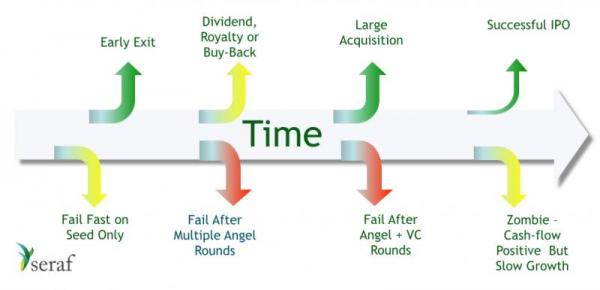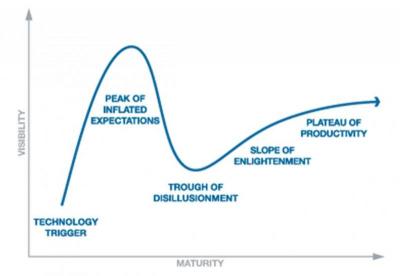Note: This article is the tenth in an ongoing series for angels new to investing. To learn more about building an angel portfolio, download this free eBook today - Angel 101: A Primer for Angel Investors or purchase our books at Amazon.com.

In Part 1 of this article, we discussed the types of exits that angel investors run into when things don’t work out so well. The failures are part of doing business as an angel. Even if you do your job well and pick great companies, you still expect half the companies to fail. But what happens to the other half? What should angel investors expect from their positive exits? Let’s revisit the chart we showed in Part 1, but this time we will examine the upward pointing arrows.

Early Exit: One of the great things about being an angel investor versus being a VC is you don’t have to swing for the fences with every at bat. Sometimes a double or a triple is a great exit for you as long as it doesn’t take too long to happen. If you double your money in under 2 years, your IRR is around 40%. I’ll take that level of return any time! Especially considering that I can immediately turn that money around and put it back into a new investment for the chance of an additional return on the money. Positive early exits usually fall into one of the following categories:
-
A new product that complements a fast growing, large company’s product line
-
A disruptive product that has the potential to damage a larger company’s market position
-
A new product that fills a newly emerging gap in a big company’s product line
-
A new product with strategic patents that a buyer cannot risk having fall into a competitor’s hands
-
A new technology or business model that is so innovative that the opportunity to get the team and the goodwill around the brand is irresistible
- A new product that is clearly constrained by lack of sales and that would be instantly accretive and profitable in the hands of a larger sales force.

As we can see from the Gartner Hype Cycle chart, early exits are best timed when a company is at the stage of “Peak of Inflated Expectations”. This tends to occur right about the time a company first releases a product, or when they get very positive results from early clinical trials in the case of a Life Sciences company. If you wait much beyond this peak, company value can drop significantly. Selling the dream is often much easier than selling the reality.
Dividend, Royalty or Buy Back: Although these three options represent less than 10% of exits in angel investing, they do happen. In most cases, startup companies burn a lot of cash and don’t have the ability to fund a dividend payout. But there are times when a company grows to a stage where additional investment isn’t needed or is not going to materially affect the valuation for any of the logical buyers, and the board decides to distribute some of the extra cash as dividends while the company is looking for a buyer. In contrast, royalty payment exits happen when angel investors structure the initial investment so the exit for the investors will be through a royalty payment instead of a buyout upon sale of the business.
The Buy Back scenario has at least two flavors. In one scenario, the company buys back shares from any investor who is interested in selling. These buy backs tend to be at a decent, but limited return to investors, and will often come at a “liquidity discount” relative to fair market value. The second case occurs when a new investor in the company (e.g. a large VC) wants to buy more stock in a company than the company wants to sell. The new investor, with agreement by the board, then reaches out to current investors offering to buy some or all of their shares. This type of exit can be quite lucrative to early investors. We’ve seen situations where shares were bought at a 4X+ premium after investors held the stock for less than 2 years.
Large Acquisition: By far the most common type of big exit for angel investors is by way of acquisition by a larger company, often a public company that can use its highly-liquid public shares as currency. This scenario represents a fast way to get cash returned to you without any lockup on selling from an IPO or from an acquisition by another privately held company. In many cases, these acquisitions include a substantial upfront payment and then a smaller (10 - 25%) escrow payment that will pay out in 12 to 18 months. For Life Science companies, it’s also common to see milestone payments and royalties, where increasingly larger amounts of capital are returned to investors as the company’s product makes it through different stages of clinical trials all the way through to FDA approval and product sales.
Successful IPO: Although IPOs are currently much less common than in recent decades, most investors still see an IPO as the Holy Grail of angel investing. It certainly gives you awesome bragging rights at cocktail parties, and a great return for your portfolio! But IPOs are a rare beast these days, particularly smaller sub-$100M ones. They still happen, but companies are staying private much longer and going out at much higher valuations than ten to twenty years ago. Given current regulations in the US, and the fact that these IPOs offer much less in the way of headline-grabbing first day “pop” than the old days, it’s doubtful that the appetite for IPOs on the part of either the public or CEOs will rebound much higher any time soon. When they happen they can be awesome returns, but just be aware that you won’t be able to sell your stock during the approximately 6 month lock-up period after the company first goes public.
We covered a lot of ground describing the many different positive and negative exit scenarios in this article and the previous article. In our next article, we will dig into some other important topics that will help you understand how to build your angel investment portfolio.
Want to learn more about building an angel portfolio and developing the key skills needed to make great investments? Download Angel 101: A Primer for Angel Investors and Angel Exits: Perspectives and Techniques for Maximizing Investment Returns, or purchase our books at Amazon.com.

